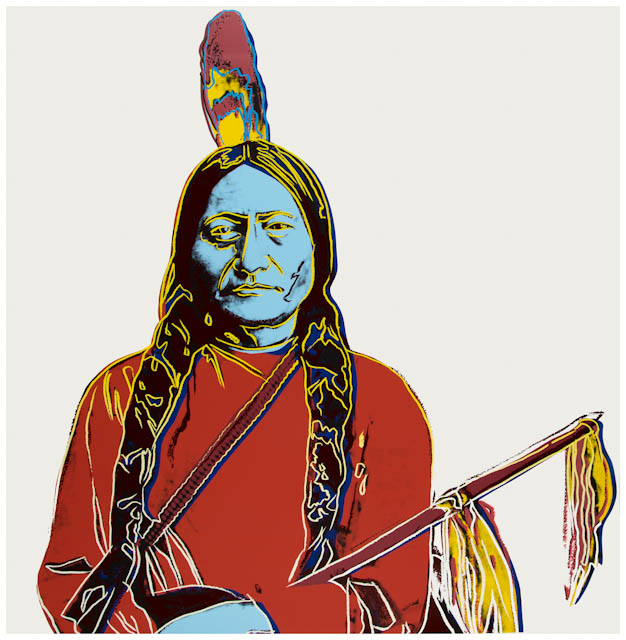| Maker(s): | Warhol, Andy | | Culture: | American (1928-1987)
| | Title: | Sitting Bull
| | Date Made: | 1986
| | Type: | Print
| | Materials: | Screenprint on Lenox Museum Board
| | Place Made: | North America; United States
| | Measurements: | Frame: 38 7/8 in x 38 7/8 in x 1 1/4 in; 98.7 cm x 98.7 cm x 3.2 cm; Sheet/Image: 36 in x 36 in; 91.4 cm x 91.4 cm
| | Narrative Inscription: | STAMP: verso, lwr r.: Extra, Out of the Edition / For Research Purposes Only / Not for Sale ; SEAL: verso, lwr r. : THE ESTATE / OF / ANDY WARHOL ; SEAL: verso, lwr r. : [ill] ; INSCRIPTION: verso, lwr r. : UP 100 ER.151.
| | Accession Number: | MH 2014.9.3
| | Credit Line: | Gift of The Andy Warhol Foundation for the Visual Arts
| | Museum Collection: | Mount Holyoke College Art Museum
|
|

|
Description:
Screenprint of a blue-faced man (Sitting Bull) from the waist up, facing toward the viewer. He is wearing a red shirt and outlined in gold.
Label Text:
At the age of just 14, Sitting Bull earned recognition as a daring and skilled warrior. He is perhaps best known for his resistance against white settlers and visions predicting the defeat of General Custer in the 1876 Battle of Little Bighorn. In this screenprint, Andy Warhol reproduces and transforms a photograph taken in 1881, shortly after the U.S. Army captured Sitting Bull. As with his portraits of Hollywood celebrities, Warhol uses a tragic image to subvert the superficiality of popular culture, here probing stereotypes and myths of America’s “Wild West.”
-Jaime Pagana, Curatorial Assistant, Mount Holyoke College Art Museum (Jan. 2017)
Hunkpapa Lakota holy man, Sitting Bull, is best known for his resistance against white settlers and his visions predicting the defeat of General Custer in the 1876 Battle of Little Bighorn. In this screenprint, Andy Warhol reproduces and transforms a photograph taken in 1881, shortly after the U.S. Army captured Sitting Bull. As with his portraits of Hollywood celebrities, Warhol uses tragic images to subvert the superficiality of popular culture, here probing stereotypes and myths of America’s “Wild West.” Together, red, yellow, and blue form a triad of primary colors, the simplicity of which belies the complexity of the print’s subject matter.
2016
Tags:
abstract; portraits; indigenous people; Native American; popular culture Subjects:
Portraits; Art, Abstract; Indians of North America; Indigenous peoples; screen prints Link to share this object record:
https://museums.fivecolleges.edu/detail.php?t=objects&type=ext&id_number=MH+2014.9.3 |